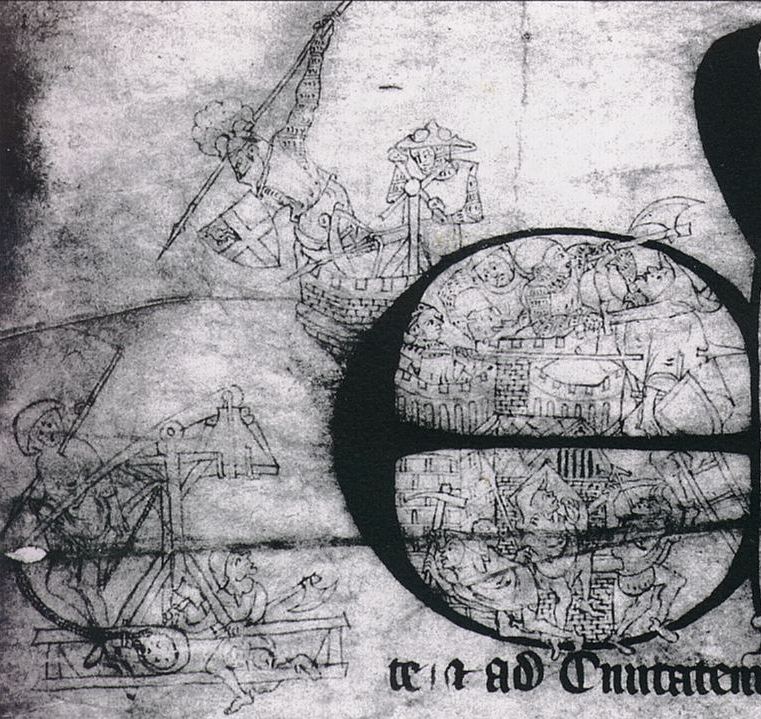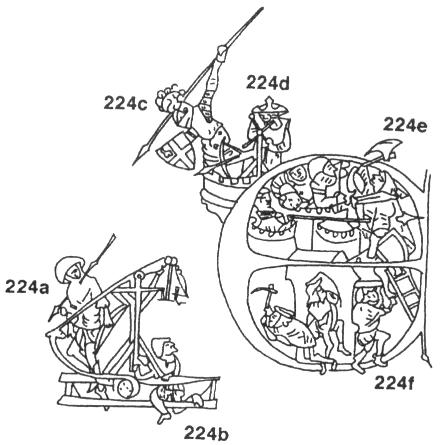
Find the perfect fit with Amazon Prime. Try Before You Buy.
Illumination from the
Charter from Edward II to the city of Carlisle, 1316AD

See a coloured image of the illumination from the Charter from Edward II to the city of Carlisle, 1316AD


A decorated initial letter on a charter from Edward II. to the city of Carlisle, dated 1316, which grants to the citizens the city, the king's mills in the city, and the fishery in the Eden. It depicts the unsuccessful Scottish siege of Carlisle the previous year by Robert Bruce.
The following account of the siege of Carlisle comes from the Lanercost chronicle, which was most probably written at Carlisle just after the siege, translated into modern English:
"From 22 July, Robert Bruce with his entire army laid siege to Carlisle for ten days. Every day of the siege they attacked one of the city gates, and some days all three gates at once, but never without loss, for the defenders hurled down on them from the walls darts and spears in such profusion that the besiegers wondered whether stones were breeding inside the walls.("The Chronicles of the Age of Chivalry", Tiger Books, 1995)
On the fifth day of the siege, the Scots set up a machine near to Holy Trinity Church, to hurl stones at the wall and gate, but despite a continuous rain of stones they did little damage, killing only one man.
Inside the city, however, there were seven or eight similar machines, as well as other engines of war called ‘Springalds’ (which hurl long darts), and slings on poles for throwing stones, all of which terrified and injured the besiegers.
Then the Scots built a ‘belfry’, a tower-like structure, considerably higher than the walls, but they never succeeded in bringing it up to the walls, because as they were transporting it on wheels across some wet and muddy ground, it sank under its own weight and could be pulled no further.
They set up long ladders, which they climbed under covering fire from a huge body of archers, whose rain of arrows prevented the defenders from putting their heads above the parapet.
But - God be praised! - the defenders found the strength to hurl the ladders away. Many of the besiegers were killed, wounded or captured, there or elsewhere around the walls, but only two Englishmen were killed throughout the siege.
After ten days, whether because they had news of the approach of English forces, or because they despaired of success, the Scots returned homewards in confusion, leaving their siege engines behind them."
The initial from a royal charter received by Carlisle. Andrew Harclay, 1st Earl of Carlisle, identifiable by the coat of arms on his shield, is seen in the tower, throwing spears at the soldiers below. This comemmorates Harclay's successfully resisting the siege of Carlisle Castle by Robert I of Scotland in July and August 1315.
Source: Prestwich, M.C. (1980) The Three Edwards: War and State in England 1272–1377, London: Weidenfeld and Nicolson, illustrations between pp. 176 and 177 ISBN: 0297777300. OCLC: 185679701.
Original held by the Cumberland and Westmorland Antiquarian and Archaeological Society.

Referenced on p.86, Arms and Armour of the Crusading Era, 1050-1350, Western Europe and the Crusader States by David Nicolle
224A-F Carlisle Charter, Cumbria, 1316
(City Library, Carlisle, England)
A highly-decorated initial illustrates the siege of Carlisle by the Scots in 1315. The Scots are, of course, shown in an unfavourable manner but nevertheless this is one of the earliest and most accurate representations of Scottish costume made by an artist who presumably knew what he was drawing. The Scots (A, B, E and F), or perhaps more accurately Scots Borderers and Galwegians, lack armour, wear capes, are apparently bare legged and have large floppy hats that bring to mind the 'blue bonnets' of later centuries. These Scots have a modern trebuchet, although one figure (B) seems uncertain how to operate it. Another figure (A) carries a relatively short bow while a group of sappers (F) includes a man with a pick. A final figure on a scaling ladder (E) wields a battle-axe. The garrison of Carlisle include a fully armoured figure with a small flat-topped shield, a perhaps visored great helm, mail hauberk, and perhaps gauntlets (C). Next to him a mailed figure with a broad war-hat and squared shoulders suggesting padded armour or a cuirie beneath the surcoat, winds a winch to load a very rarely illustrated siege-crossbow (D). The devastating impact of this large, frame-mounted great crossbow is seen in the large arrow or bolt that has transfixed the Scots archer. Other defenders of the citadel (E) include a man with a spear and another with a falchion.